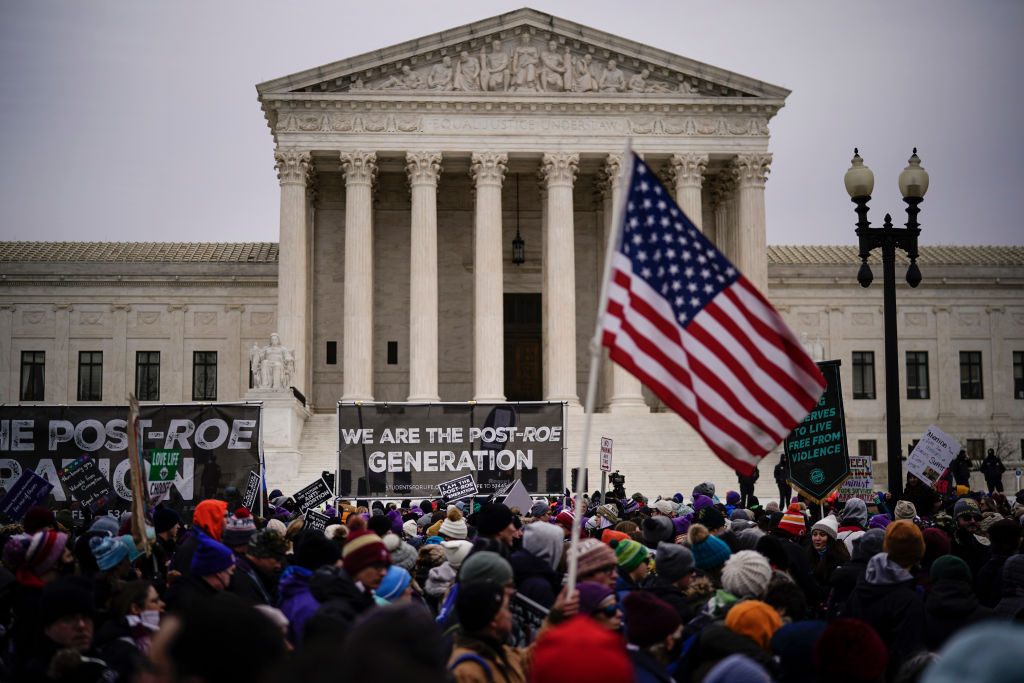January 22, 1973: a day of infamy, if terminating a pregnancy by killing the unborn is murder – or of glory, if it symbolizes the “right to choose.” What Supreme Court decision but Roe v. Wade has remained so consistently controversial, so incessantly inspiring to true believers on both sides, even half a century later? With recent judicial actions regarding the Texas heartbeat bill, anti-abortion activists may have reason to hope this 49th anniversary will be the last – but will it? How fares the ruling in 2022?
Request Denied
 The law in the Lone Star State allowing private individuals to sue anyone who provides or enables an abortion beyond the detection of a fetal heartbeat went into effect in September 2021 and has moved through the courts in multiple challenges with various outcomes. The legal battle is far from over, but the Supreme Court has delivered a decision seen by many as a blow to the “pro-choice” side. The restriction had been sent to the Texas Supreme Court, but abortion providers filed a request that SCOTUS intervene and send it back to a federal district court, where it had previously been blocked.
The law in the Lone Star State allowing private individuals to sue anyone who provides or enables an abortion beyond the detection of a fetal heartbeat went into effect in September 2021 and has moved through the courts in multiple challenges with various outcomes. The legal battle is far from over, but the Supreme Court has delivered a decision seen by many as a blow to the “pro-choice” side. The restriction had been sent to the Texas Supreme Court, but abortion providers filed a request that SCOTUS intervene and send it back to a federal district court, where it had previously been blocked.
The High Court denied the request Jan. 20, and so the law will remain in effect, at least until the state’s top court gives its answer to the 5th U.S. Circuit Court of Appeals. While the majority offered no explanation, the minority did. Justice Sonia Sotomayor authored a heated dissent, joined by Justices Stephen Breyer and Elena Kagan. “This case is a disaster for the rule of law and a grave disservice to women in Texas, who have a right to control their own bodies,” Sotomayor wrote. “I will not stand by silently as a state continues to nullify this constitutional guarantee.” That, of course, is the pro-choice position: When the 1973 Supreme Court ruled, it claimed abortion fell under the right to privacy, which was considered “broad enough to encompass a woman’s right to terminate a pregnancy.”
Long-Standing: A Relative Term
When folks argue passionately against challenging a precedent, they often talk about how long it has stood. How can one dare oppose this “long-standing” ruling that protects the “long-standing” right of women to abort? In 2008, Justice Antonin Scalia declared that the decision in District of Columbia v. Heller should “cast no doubt on the long-standing prohibitions on the possession of firearms by felons or the mentally ill, or of laws forbidding the carrying of firearms in sensitive places such as schools and government buildings.” At that time, the National Firearms Act of 1934 had been in place for 74 years – out of the 220 since the Constitution took effect in 1788. The Gun Control Act of 1968 could claim a mere 40.
 January 22, 2022, makes 49 years of Roe v. Wade. According to the University of Pittsburgh Law Review, at the adoption of the Declaration of Independence in 1776, abortion was banned in all 13 American colonies. They had inherited English Common Law, and as such, abortion was a misdemeanor before and a felony after the time a woman could first feel her baby move – called in those days the quickening. That remained largely the case until the early 1800s when medical science had evolved enough to realize life begins at conception. By the 1860s, almost every state had outlawed abortion – at any point – as a felony. A variety of laws were passed across the nation over the years and, in 1973, the Supreme Court ruled – in the process of striking one down – that the killing of an unborn child was a woman’s own business and protected by her right to privacy.
January 22, 2022, makes 49 years of Roe v. Wade. According to the University of Pittsburgh Law Review, at the adoption of the Declaration of Independence in 1776, abortion was banned in all 13 American colonies. They had inherited English Common Law, and as such, abortion was a misdemeanor before and a felony after the time a woman could first feel her baby move – called in those days the quickening. That remained largely the case until the early 1800s when medical science had evolved enough to realize life begins at conception. By the 1860s, almost every state had outlawed abortion – at any point – as a felony. A variety of laws were passed across the nation over the years and, in 1973, the Supreme Court ruled – in the process of striking one down – that the killing of an unborn child was a woman’s own business and protected by her right to privacy.
So for the first 185 years of the Republic, this was not a constitutional right, nor was it allowed even before the Constitution. How’s that for long-standing? Only in the last half-century did judges rule that the document, which makes no mention of abortion despite being authored by legal experts in a time when the practice was illegal, was meant to protect a woman’s right to terminate a pregnancy.
The State of the Ruling in 2022

(Photo by Anna Moneymaker/Getty Images)
How does America feel about the issue today? Well, the thousands who attended the 49th March for Life on Friday, Jan. 21, certainly hope this is the last anniversary they’ll have to protest. The broader population, however, didn’t seem to agree, the last time Fox News asked. About two-thirds of those questioned (65%) say they want to see the Roe ruling stand, while only 28% said it should be overturned. On a deeper dive into the issue, however, people were more divided. Abortion should be legal in all cases, according to 29%. Another 20% said it should be legal in most cases, while 38% said only in certain cases – like rape, incest, or to save the life of the mother – and 11% believed it should be against the law no matter what the circumstances.
Of course, popular opinion matters in the choosing of presidents, who appoint federal judges, and in selecting members of the Senate, who approve those presidential nominees. But the people get no say directly in which judges or Supreme Court Justices are nominated or confirmed – and certainly no say in how they rule. The law that so offends Justice Sotomayor must clear the Texas Supreme Court and the 5th U.S. Circuit Court of Appeals. Anything could happen here, though it seems likely to survive. Regardless, of course, someone will be dissatisfied with the outcome and petition the High Court. If and when SCOTUS hears the case, will the conservative majority rule as the left fears and the right hopes? And if they do, will that mean the end of Roe v. Wade?
Liberty Nation Chief Political Correspondent Graham J. Noble asked Scott D. Cosenza, Esq., LN’s legal affairs editor, that very question. He replied:
“Graham, it all depends on the specific holding. We could have a situation where Justices agree in the result (the ban stands) but disagree why. These plurality opinions make a mess in their application and have confusing precedential value. The court could also go further than allowing the Texas ban. A majority of Justices could rule that humans are endowed with full rights prior to the third trimester. They could find that a right not to be aborted exists in fetuses nationwide, extending any ruling well past Texas. It’s fair to call that a long shot, but if they start re-writing a landmark opinion, who knows where they might end up.”
It’s entirely possible the landmark decision won’t live to see 50 – or the High Court could reject the law entirely. Another bit of judicial wisdom Cosenza has mentioned many times before, in one form or another, applies here as well: If you expect to be disappointed, SCOTUS will rarely let you down.
~Read more from James Fite.




